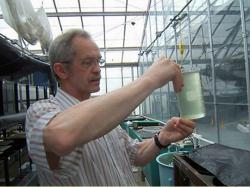Ohio State Scientists Net 'Spectacular' Results In Yellow Perch Production
June 29, 2011 | 3 min to read

COLUMBUS, Ohio — Aquaculture sales in Ohio more than tripled from $1.8 million to $6.6 million in recent years, and nationally, Ohio ranks first in sales of yellow perch for food.
But currently, most fish farmers get fingerlings from traditional, low-intensity pond cultures where farmers are at the mercy of good weather and a lot of luck. That makes the supply of yellow perch juveniles limited and costly.
So far, the industry has had little luck in producing yellow perch larvae with high survival rates. But Ohio State University's Konrad Dabrowski and his graduate students may have cracked the code.
Several years ago Dabrowski was the first to figure out how to manipulate water temperature and light to be able to spawn yellow perch at any time of the year — spring, summer or fall. However, even when larvae were produced successfully, another challenge loomed: how to feed the larvae and grow them into healthy fish even when ice is covering the ponds.
Now, after nearly two decades of trial, error and basic research, Dabrowski believes he has found just the right combination needed to allow the larvae to thrive.
"I think we have found something pretty spectacular," said Dabrowski, an aquaculturist with the university's Ohio Agricultural Research and Development Center and a professor in the School of Environment and Natural Resources.
"I've seen this problem for all 22 years I've been here working in aquaculture," Dabrowski said. "Over the years we made some progress, but now, finally, I'm convinced our findings will have a major impact on the industry."
Konrad Dabrowski examines minuscule yellow perch larvae. Dabrowski's research has increased the larvae's chances of surviving to a marketable size.
Konrad Dabrowski examines minuscule yellow perch larvae. Dabrowski's research has increased the larvae's chances of surviving to a marketable size.
Most yellow perch larvae grown in high-density controlled conditions have not survived because of many challenges, including an inability to inflate the swim bladder. The swim bladder must be inflated within the first few days of life. To do so, larvae swim to the water surface and gulp in a bit of air. An inflated swim bladder allows a fish to retain buoyancy and keep from floating up or sinking down in the water. Dabrowski's research team adjusted conditions in the starter tanks so that 50 to 70 percent of the larvae were successful in inflating their swim bladders.
Another challenge was finding a proper starter diet — "baby food," as Dabrowski calls it — that would be available year-round for the freshwater fish, and determining how old the fish should be to make adjustments in the feed. Environmental conditions also needed to be refined to allow for the greatest survival rates.
"All of these elements together — turbidity, salinity, amount of light, density of fish, food type, frequency of feeding — you only have hours after hatching to know if the conditions you supplied are right," Dabrowski said. "If something is missing or wrong, the evidence appears very quickly — in terms of dead larvae. You can get to a point of no return within hours or days."
Dabrowski and Ph.D. student Michael Wojno believe they have found just the right combination needed. So far, their larvae experience a 50 percent survival rate in the first two weeks. After that, the larvae's survival is practically ensured until they reach marketable size.
In addition, the researchers have conducted similar work on striped bass hybrids for the Ohio Division of Wildlife, which currently ships in fish from Arkansas to stock inland reservoirs and lakes. The Ohio State investigators have achieved an 80 percent survival rate from the larval stage for hybrid striped bass, and the fish reached one inch in three weeks.
Dabrowski feels these findings are more than promising — they could be revolutionary for Ohio's aquaculture industry. "We need to upscale what we have to commercial conditions," he said. "We'll be able to grow fish in high-density, controlled conditions any time of the year."
Source: Ohio State University Extension
